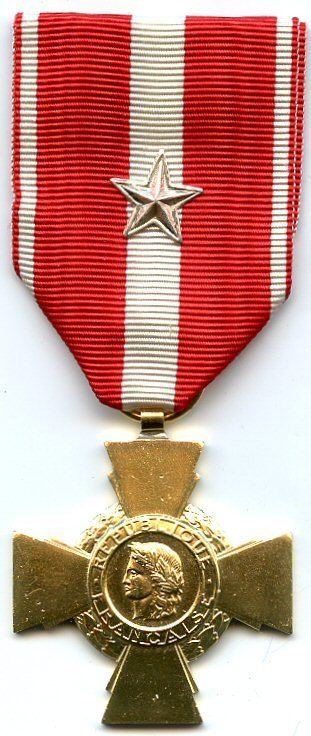Type Bravery award Established April 11, 1956 | Status Active | |
 | ||
Next (lower) | ||
The Cross for Military Valour (French: Croix de la Valeur Militaire) is a military decoration of France. It recognises an individual bestowed a Mention in Dispatches earned for showing valour in presence of an enemy, in theatres of operations which are not subject to the award of the Croix de guerre des théâtres d'opérations extérieures (Cross of War for Foreign Theatres of Operations). The Cross for Military Valour is usually awarded for security or peacekeeping operations, always outside the French territory.
Contents
History
It was established in 1956 to reward soldiers, sailors, and airmen serving in Algeria who had committed acts of valour or gallantry in combat. Algeria was a department of France at the time, so it was not considered a declared war but peacekeeping operations on French soil. Therefore, the War Cross for foreign operational theatres, which had been awarded for valiant service in Indochina, was not considered appropriate. Médaille de la Valeur Militaire was created on 11 April 1956 with a four-grade system of distinctions. To put it on the same level as the Croix de guerre, the Medal was replaced by a Cross on 12 October 1956.
The Cross was used extensively to reward soldiers for valour in every French military operations since 1956, except the Gulf War and the Kosovo War, when Overseas War Crosses were awarded in place of Crosses for Military Valour :
Grades of distinction
The grades of the Cross are insignia of a mention in dispatches, which can be of one of five levels matching the valour displayed by the recipient while in presence of an enemy. They are named after historical formation of the French military.
Eligibility and awarding process
The 1956 Cross was meant principally for soldiers, but a provision was made for civilians participating in a peacekeeping operation. On 2 December 2005 this provision was amended in order to reward only civllian employees of the Ministry of Defence on official missions overseas. Originally, the cross was not awarded to members of foreign militaries or governments. This restriction was lifted on 9 November 2011 for acts of valour or performed valiant service while on joint operations with French forces. Collective awards can be made to military units, both French and foreign, since 2011. When a unit has decorated twice with the Cross at its highest level, the fourragère can be worn on uniforms.
The four first grades of the Cross can be awarded by Chef d'état-major des Armées (Chairman of the Joint Chiefs of Staff), but the Cross with Palm decoration is only awarded by the Minister of Defence.
Award description
Medal: suspended from a ribbon is a 36 mm bronze cross, with an effigy of the Republic crowned with a wreath, with the edge embossed: "REPUBLIQUE FRANCAISE". On the reverse is the inscription: "Croix de la Valeur militaire".
Ribbon: a red bar with three vertical white bands: a centered 7 mm band, with a smaller 2 mm band on each end.
